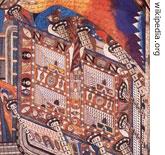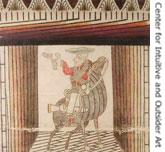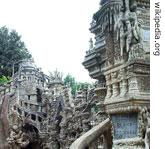-
(单词翻译:双击或拖选)
VOICE ONE:
I’m Steve Ember.
VOICE TWO:
 |
| Detail from a drawing by Adolf Wolfli from 1910 |
And I’m Barbara Klein with Explorations in VOA Special English. Today, we travel to several countries exploring the world of Outsider Art. This powerful form of creative expression usually involves art made outside the limits and rules of official culture.
Often, outsider artists have not been formally trained. They use their skills to create visual examples of personal observations, invented worlds, and even severe mental conditions.
(MUSIC)
VOICE ONE:
The Outsider Art movement has many names and forms. Experts debate about the differences between terms such as Naïve Art, Visionary Art, Folk Art, Intuitive Art and Outsider Art. It would be impossible to explain the entire debate, so we will just tell a few stories about some great artists. The art itself will explain what is special about these similar movements.
VOICE TWO:
Mental health experts helped bring public attention to one form of outsider art. For example, in nineteen twenty-one, a Swiss doctor, Walter Morgenthaler published a book about the art of his patient, Adolf Wolfli. Mister Wolfli was one of the early outsider artists who received popular recognition1. During his thirty-five years in a mental hospital in Switzerland, Mister Wolfli created twenty-five thousand pages of drawings and stories.
Adolf Wolfli was a poor farm worker who was placed in a mental hospital in eighteen ninety-five. He soon started making color drawings that he organized into books. For example, around nineteen twelve he finished a nine-book series called “From the Cradle2 to the Grave.‿nbsp; In this work Mister Wolfli turned his sad childhood into a magical travel story. He included detailed3 drawings of maps, creatures, rulers, and even talking plants to help capture this imaginary world. In other books, he recreated and renamed the world and universe. He described this world using songs, poetry, and drawings.
VOICE ONE:
In the nineteen forties the French artist Jean Dubuffet discovered Mister Wolfli’s works and other artists like him. He called this kind of artwork “Art Brut‿which is French for “raw art‿ He described Art Brut as being created from pure and real creative forces. He saw outsider artwork as being free from the worries of competition and social acceptance that define4 the official art world. He argued that the official culture of museums, galleries and artists had lost its power. Art Brut, he said, was still true and powerful art. Jean Dubuffet soon started collecting this kind of art made by mental patients, prisoners and even children. In nineteen seventy-one he donated his personal collection of Art Brut to the city of Lausanne, Switzerland.
(MUSIC)
VOICE TWO:
One way to learn more about this movement is to explore its artists. The American Folk Art Museum in New York City has several rich and inventive drawings by the self-taught artist Martin Ramirez. Mister Ramirez was born in the Mexican state of Jalisco in eighteen ninety-five. He left his wife and family in the nineteen twenties to find work in the American state of California.
But the United States was going through the economic problems of the Great Depression. As a result, Martin Ramirez was soon homeless and unable to find work. Police picked him up in Northern California in nineteen thirty-one. He was placed in a mental hospital and told he had a severe mental illness. He spent the next thirty-two years in mental hospitals.
VOICE ONE:
But there is a happier side to his tragic5 story. Mister Ramirez might not have been able to express himself in English, but he could do so with his art. In the late nineteen thirties, he started to collect small pieces of paper including food paper packaging, paper cups and book pages. On the large paper surfaces he pieced together, he drew pictures using colors he made from crushed pencils and crayons.
 |
| Detail from "Untitled (Caballero)" by Martin Ramirez. Made around 1950. |
Over the years, Mister Ramirez drew hundreds of detailed pictures. The horse and rider is one subject he repeatedly drew. He also drew trains and tunnels. His strong repeating lines show depth and motion. Some of his trains come out of mountains, while others go over bridges.
In the early nineteen fifties, a professor of psychology6 and art named Tarmo Pasto visited Martin Ramirez. Professor Pasto recognized the artistic7 value of Mister Ramirez's drawings. He gave him art supplies and even organized exhibitions of his work. Most importantly, he made sure Ramirez's art survived and was not thrown away by hospital workers. The extraordinarily8 skillful and powerful drawings of Martin Ramirez are now a cultural treasure.
(MUSIC)
VOICE TWO:
Many outsider artists have very successful careers during their lifetime. The artist known as Mister Imagination was born Gregory Warmack in nineteen forty-eight in Chicago, Illinois. He grew up in a poor family. As a young man he made jewelry9 out of thrown away objects and sold it in local restaurants. One night he was robbed and shot twice in the stomach. At the hospital he fell into a coma10 and was unable to communicate.
| Detail of "Button Cane with Self-Portrait" by Mr. Imagination |
He had a dreamlike vision of a bright light. He later said it represented artists from the past entering his body and mind to guide him. He decided12 that art would be his life goal and soon changed his name to Mister Imagination. He makes artistic statues from bottle caps and other found objects. They have been shown in galleries and museums across the United States.
These include the American Visionary Art Museum in Baltimore, Maryland. This museum has more than four thousand pieces by what it calls "visionary" artists. About fifty works are shown at any one time in its permanent collection.
(MUSIC)
VOICE ONE:
Ku Shu-Lan also enjoyed public recognition of her creations14. She was born in nineteen nineteen in the Shaanxi area of China. Like many women in the area, Ku Shu-Lan was very skillful at the art of paper cutting. She often had visions of a magical goddess covered in flowers coming to her in a garden. She said the woman was herself, the paper-cutting goddess. Ku Shu-Lan lived with her husband in a cave carved from earth.
There was not much color in her life, so she made her own. She covered the walls of her home with her richly colored cutouts of this goddess. Some of her images have thousands of finely cut shapes. They are so detailed it is hard to believe the images are not painted. In nineteen ninety-six, Ku Shu-Lan fell and hurt herself. She was in a coma and was not able to communicate for several weeks. Her family started to plan for her burial. But, she later woke up. The first thing she asked for was a pair of scissors so she could start another paper creation13.
VOICE TWO:
 |
| Ferdinand Cheval's Ideal Palace |
Other outsider artists use their skills to create entire environments. For example, in Hauterives, France, you can see the Ideal Palace made by a mailman named Ferdinand Cheval. One day in eighteen seventy-nine while delivering mail Mister Cheval found a rock with a strange shape. He decided it was a sign that he needed to make his dream of being a building designer a reality. He spent the next thirty-four years of his life collecting stones and building a wildly imaginative15 palace building. Mister Cheval mixed periods and styles of Chinese, North African, and Northern European architecture. Today, people can visit this building to experience this mailman's hard work and creativity.
VOICE ONE:
Helen Martins created a whole other kind of magical environment in the town of Nieu-Bethesda, South Africa. In nineteen forty-five, Miz Martins found that the world looked gray and colorless. She decided she needed to brighten her life. So, at the age of forty-seven she started to glue crushed colored glass in special designs on every surface in her house. Then, she started making statues out of cement material and glass. She read poetry, religious books, and art history to find ideas for her creations. Helen Martins hired two workers to help her create her Owl16 House and the surrounding Camel Yard.
VOICE TWO:
By the time of her death in nineteen seventy-six, the yard had more than three hundred statues of animals and imaginary creatures. All of them face east toward the Muslim holy city of Mecca. Visitors can enjoy the brightness17 and color of the universe she created. Like Helen Martins, outsider artists add new life, imagination and skill to the world of creative expression.
(MUSIC)
VOICE ONE:
This program was written and produced by Dana Demange. I’m Steve Ember.
VOICE TWO:
And I’m Barbara Klein. You can read and listen to this program on our Web site, voaspecialenglish.com. Join us again next week for Explorations in VOA Special English.
 收听单词发音
收听单词发音
1
recognition

|
|
| n.承认,认可,认出,认识 | |
参考例句: |
|
|
|
2
cradle

|
|
| n.摇篮,策源地,支船架;vt.把...放在摇篮里 | |
参考例句: |
|
|
|
3
detailed

|
|
| adj.详细的,详尽的,极注意细节的,完全的 | |
参考例句: |
|
|
|
4
define

|
|
| vt.解释,下定义,阐述,限定,规定 | |
参考例句: |
|
|
|
5
tragic

|
|
| adj.悲剧的,悲剧性的,悲惨的 | |
参考例句: |
|
|
|
6
psychology

|
|
| n.心理,心理学,心理状态 | |
参考例句: |
|
|
|
7
artistic

|
|
| adj.艺术(家)的,美术(家)的;善于艺术创作的 | |
参考例句: |
|
|
|
8
extraordinarily

|
|
| adv.格外地;极端地 | |
参考例句: |
|
|
|
9
jewelry

|
|
| n.(jewllery)(总称)珠宝 | |
参考例句: |
|
|
|
10
coma

|
|
| n.昏迷,昏迷状态 | |
参考例句: |
|
|
|
11
cane

|
|
| n.手杖,细长的茎,藤条;v.以杖击,以藤编制的 | |
参考例句: |
|
|
|
12
decided

|
|
| adj.决定了的,坚决的;明显的,明确的 | |
参考例句: |
|
|
|
13
creation

|
|
| n.创造,创造的作品,产物,宇宙,天地万物 | |
参考例句: |
|
|
|
14
creations

|
|
| 创造( creation的名词复数 ); 创造物; (尤指所述由上帝)创造天地; 宇宙 | |
参考例句: |
|
|
|
15
imaginative

|
|
| adj.富有想象力的,爱想象的 | |
参考例句: |
|
|
|
16
owl

|
|
| n.猫头鹰,枭 | |
参考例句: |
|
|
|
17
brightness

|
|
| n.明亮,亮度,聪颖,光泽度,灯火通明 | |
参考例句: |
|
|
|















